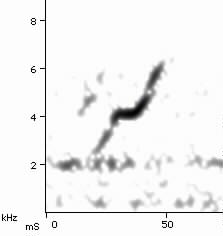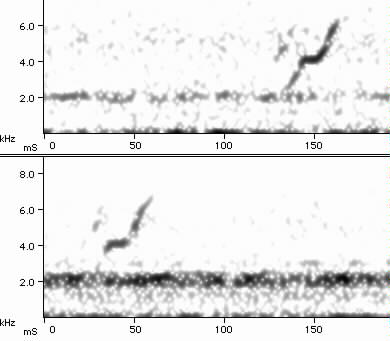
presumed Least Flycatcher nocturnal flight calls
Fig.2. Wisconsin May 16, 2001 (WRE).
Nocturnal flight call sequence:
1. Wisconsin May 16, 2001 (WRE). Bird in flight with Swainson's Thrush calling in the background. Recorded at 9:39PM CDT. Sunset was at ~8:40PM CDT. Night flight calls of migrants had been detected for about 15 minutes before this flight call sequence was recorded. This recording is one channel of a two channel recording setup on a 220-ft. meteorological tower on the edge of a wind turbine farm in Door County, Wisconsin. One microphone was located near the top of the meteorological tower and the other about 20-ft. above ground level. Fig.A shows a picture of the tower. The purpose of this recording setup was to provide a rough assessment of the altitude of night-migrating songbirds in the vicinity of the wind turbine farm. The call of a migrating bird is picked up by the microphones at different times depending on the calling bird's position in the air. Calls given while birds are flying on the plane between the two microphones (~110-ft above ground level) will be picked up by the microphones at approximately the same time. In other words, there will be no time delay in their arrival time at the microphones. Birds calling from directly over the tower will have a time delay of roughly 200 mS between their arrival at the top microphone and the lower microphone. Fig.B illustrates the hyperbolas (set of points) where birds may have called when different time delays are recorded. The hyperbolas are two dimensional representations. In actuality the set of points is a three dimensional hyperboloid. But for assessing the altitude of the caller, two dimensions is sufficient. Another dynamic of the microphone setup was that the top microphone was angled ~30 degrees from the zenith toward the east and the lower microphone was angled ~30 degrees toward the west. In the full recording sequence, this presumed Least Flycatcher calls 10 times. The first three calls are recorded only by the upper, east facing, microphone. The following six calls were recorded by both microphones, and the last call was only recorded by the west facing lower microphone. This sequence of call detection suggests that the bird had a vector of movement from east to west.

Fig.3. Wisconsin May 16, 2001 (WRE).
Fig.3. is a spectrogram of a two-channel recording of a presumed Least Flycatcher call during nocturnal migration. The lower spectrogram is the recording of the call from the top microphone. The upper spectrogram is from the lower microphone. The arrival time delay at the two microphones is 106.5 mS. This means that the bird at the time it calls is a minimum of 163-ft. above the ground. This minimum would be if the bird was sitting 163 feet high on the tower. In fact the bird was detected flying for more than a minute somewhere within the pickup range of the microphones near the tower. The bird is therefore higher than 163-ft above the ground. The six calls from the bird that were picked up by both microphones indicate that the bird was either increasing altitude or was flying directly toward the tower because the time delays in the six calls progressively increased from 69 mS to 109 mS. Analysis of the loudness of the six calls indicates that they were generally get louder on both channels then get weaker. This data suggest the bird was getting closer to and then farther away from the tower.
The point of this whole illustration is that we have documented that a presumed Least Flycatcher was flying fairly high above ground giving its "pwit" note in nocturnal flight. If we had only had one microphone with a remote recording on the ground we would not have been able to distinguish the minimum altitude of the bird, and that it was in flight at night. The variation in loudness of the calls seen on one channel may have been due to a perched bird changing the direction that it vocalized in. This recording is our only evidence that Least Flycatchers do occasionally give their "whit" note in sustained nocturnal flight.